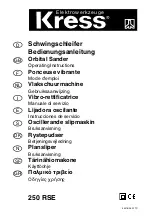
7
SELECTING A TABLE INSERT
SELECTING THE RIGHT GRADE
OF SANDING SLEEVE
Failure to use the correct table insert with its
matching sanding sleeve could result in pinched
fingers or the workpiece being pulled down between
the table insert and the sanding sleeve.
The sanding sleeve should fit snugly into the central
cut-out of the table insert.
Use the following chart to help determine the correct
table insert and upper spindle washer to use with
each sanding sleeve.
Sanding Sleeve
Diameter
Table Insert
Size
Upper Spindle
Washer (9) Size
13mm / 1/2”
13mm / 1/2”
Small
19mm / 3/4”
19mm / 3/4”
Medium
26mm / 1”
26mm / 1”
Medium
38mm / 1 1/2”
38mm / 1 1/2”
Large
51mm / 2”
51mm / 2
Large
76mm / 3”
76mm / 3”
Large
Sanding sleeves are available in a variety of different
• Grades: coarse (80 grit)
• Medium (160 grit)
• Fine (240 grit)
Use a coarse grit to sand down rough finishes,
medium grit to smooth the work, and fine grit to
finish off.
Always use good quality sanding sleeve to maximise
the quality of the finished task.
It is advisable to do a trial run on a scrap piece of
material to determine the optimum grades of sanding
sleeve for a particular job.
If there are still marks on your work after sanding,
try either going back to a coarser grade and sanding
the marks out before recommencing with the original
choice of grit, or try using a new piece of sanding
sleeve to eliminate the unwanted marks before going
on to a finer grit and finishing the job.


































